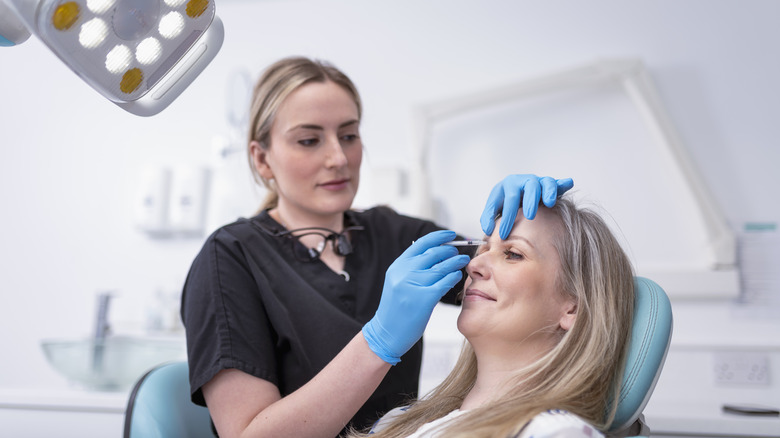The Type Of Surgery Medicare Won't Cover For Seniors
Medicare was signed into law on July 30, 1965, as part of the Social Security Amendments. President Lyndon B. Johnson described it as a promise that older Americans would no longer be denied access to modern medical care. Since that time, the program has helped millions of seniors avoid overwhelming medical costs and get the care they need. But Medicare has its limits. Section 1862(a)(10) of the Social Security Act states that it won't cover surgery done only to improve a person's appearance. So, any procedure that's purely cosmetic is not included in Medicare's healthcare benefits.
Examples of cosmetic procedures Medicare won't cover include eyelid lifts for droopy lids (blepharoplasty), wrinkle-smoothing Botox shots, tummy-tuck surgeries that remove extra belly skin (panniculectomy), nose reshaping (rhinoplasty), spider or varicose vein treatments, and breast enlargements done for appearance alone. And this is outside of other medical costs Medicare won't cover for seniors. Congress built this rule into Medicare from the start. Section 1862(a)(10) of the Social Security Act only allows it to cover care that's considered "reasonable and necessary." If the procedure is just to improve appearance, it doesn't meet that standard, so Medicare will not cover it.
When Medicare will pay for cosmetic surgeries
Medicare does cover certain surgeries that restore function or correct physical damage, as long as the goal isn't purely cosmetic. According to the official Medicare coverage page, cosmetic procedures are not covered "...unless you need it because of accidental injury or to improve the function of a malformed body part." The page uses breast reconstruction after a mastectomy, as an example. In this case, the focus is on restoring health.
Some surgeries can be either cosmetic or medical. This is why Medicare requires prior authorization for certain outpatient procedures that can fall into that gray area. Since July 2020, a Centers for Medicare & Medicaid Services (CMS) rule has required hospitals and outpatient surgery centers to get written approval before billing for procedures like eyelid lifts (blepharoplasty), tummy-tuck-style skin removal (panniculectomy), nose reshaping (rhinoplasty), vein treatments, and Botox injections. If a provider skips this step and sends in a claim without prior authorization, Medicare will deny payment.
Patients who need reconstructive surgery should make sure their surgeon submits the prior authorization paperwork well before the procedure. This should include medical notes, clear photographs, and a detailed letter explaining how the surgery will improve function, not just appearance. Submit everything early to avoid delays. It will also give Medicare the information it needs to approve the claim.
Footing the bill yourself
After Medicare rules out a purely cosmetic procedure, some senior might opt for an unsecured personal loan. According to NerdWallet's 2025 review of lenders that offer plastic-surgery loans, interest rates can vary widely; from around 6% for borrowers with excellent credit to 35% to 36% for those with lower scores. Seniors fall in the former because they tend to have higher credit scores going by the average credit score by age.
If it is a procedure that costs a few thousand dollars, some surgeons may recommend CareCredit, a healthcare credit card issued by Synchrony. Investopedia explains that CareCredit can provide financing for six to 24 months with no interest, as long as you pay off the full balance within that period. If any amount remains at the end, interest is charged retroactively from the date of purchase. Patients who need more time can choose fixed monthly payments over 36 to 60 months, but these plans come with double-digit interest rates. Be careful though; the added cost can push the total beyond the original price of the surgery.
No matter how you plan to pay, treat cosmetic surgery financing like any big purchase. Get quotes from multiple lenders and compare the full annual percentage rate and fees. If the procedure is more than a year away, set aside money in a high-yield savings account. If it's coming up soon, lock in the lowest rate available and make sure the monthly payment fits your budget.


